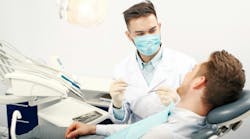Embracing evolution: How dental leaders navigate the shift from traditional to digital practices
Dentistry continues its seismic shift as digital technologies reshape patient expectations and operational norms. Experienced dental practitioners are at the forefront of this transformation, embracing innovations to meet the demands of younger patients (and dental professionals) and align with the evolving needs of the profession.
The face of dentistry is also changing. A recent RTI report found the 2022 graduating class of new dentists to be the most racially and ethnically diverse in history, with 48% of students identifying as non-white. Recent graduates of dental schools are more diverse than both practicing dentists and the US population. Additionally, 53% of graduates were women.1
This increased diversity in dentistry, brought by younger dental professionals, means that dentists' practices are also changing. According to the 2023 RTI report, only 36% of dentists were actively practicing in a solo practice. Most dentists were part of a group practice. Thirteen percent reported affiliation with a dental services organization (DSO).1
Young dentists prefer group practices. DSOs were most common among early career and women dentists. While young dentists seek DSOs that offer corporate comforts and stability and abandon solo practices (at least early in their careers), their older colleagues are retiring from the profession earlier than in the past. A January 2022 analysis from the ADA found that the average retirement age for dentists has dropped to 67.9 years old, down from a peak of 69.1 in 2018.2
Millennial dentists are more likely to enter dentistry using the DSO model rather than attempting to start their own practices.3 However, this is not the end of their differences. Young dentists also want to work in a practice that is fully immersed in technology, specifically cloud solutions.
Scientific American notes that while dentists may continue to spend most of their time practicing in an office, they will increasingly rely on new technologies, cameras, an internet connection, and greater collaboration.4 Millennials, like their dental practicing counterparts of similar age, also demand more convenient dentistry, including evening and weekend appointments. This is the “Uberization effect,” the ability to get whatever one wants quickly. Dental practice leaders are responding to this change in the care of dentistry.
Another thing patients want is convenience—easy online scheduling, minimal waiting times, and dental practices that have embraced technology. If there's anything that dental practices of all stripes have going for them, it’s that they’re moving forward with digital transformation. Continued advancements in digital dentistry are bringing about unprecedented changes in how dental practices operate, serve patients, and enhance patient experiences.
Enhanced patient experience
Digital technologies afford minimally invasive procedures and precise restorations, enhancing patient comfort and satisfaction. For example, teledentistry and digital communication channels increase accessibility, allowing for remote consultations and follow-ups.
Additionally, tools like intraoral cameras, 3D imaging, and emerging technologies such as digital mirrors facilitate patient education opportunities, leading to increased engagement in treatment plans. These advancements are enhancing patient education and engagement in treatment plans.
Cameras capture high-quality images inside the mouth to show patients detailed views of their teeth and gums on a screen in real time. This visual aid helps them better understand their oral health conditions, making it easier for dentists to explain treatment options and patients to grasp the importance of various procedures.
3-D imaging techniques, such as cone beam computed tomography (CBCT), also provide a comprehensive, 3D view that dentists can use to assess the structure of teeth, bones, nerves, and surrounding tissues. This technology allows for more precise diagnoses and treatment planning, which improves patient outcomes and satisfaction.
Finally, if young patients want practices with the latest technology, digitized mirrors provide detailed visuals of the oral cavity, with direct visualization of hard-to-reach areas and proper illumination during exams and treatments. On-demand lighting on the mirror illuminates all portions of the mouth. A staple of dental care, digital mirrors capture records, including voice notes, and they may eventually be able to take the place of intraoral cameras to provide dentists with insights about their patients’ oral care to streamline the exam process even further. Its capabilities enable point-of-care discussions with patients about needed care while chairside, better patient engagement, and improved ability for increased revenue capture.
Understanding patient's technology needs
To effectively cater to the needs of young patients and stay abreast of technological advancements, dental practices must prioritize understanding patient demographics and preferences. Strategies include:
- Using digital tools for patient education.
- Adapting to technological advancements.
- Addressing oral health challenges through preventive care and innovative treatment options.
The integration of digital dentistry offers myriad benefits, aligning with the preferences of young patients and improving the efficiency of dental practices. From increased precision and accuracy to enhanced patient experience and sustainability, the advantages are far-reaching, underscoring the importance of embracing digital innovation in dental care.
Collaboration between generations of dentists is paramount in driving practice innovation and enhancing patient care. Strategies include:
- Promoting interdisciplinary collaboration.
- Leveraging technology for integrated care.
- Incentivizing innovation through partnerships with dental insurers and payers.
As the dental landscape evolves, practice leaders must embrace digital innovation to meet the needs of younger patients and ensure the sustainability of their practices. By integrating advanced technologies, fostering collaboration between generations of dentists, and prioritizing patient engagement, practices can position themselves as leaders in modern dental care, driving positive outcomes for both patients and practitioners.
References
1. The state of dentistry–economic and demographic trends impacting the industry in 2024. Association of Dental Support Organizations. January 2024. https://www.theadso.org/wp-content/uploads/2024/01/20240115_RTI_Report_Executive_Summary_v0222.pdf
2. Ebert S. Why the great resignation offers opportunity for young dentists. American Dental Association. June 8, 2022. https://www.ada.org/publications/ada-news/viewpoint/my-view/2022/june/my-view-why-the-great-resignation-offers-opportunity-for-young-dentists
3. Post J. Millennials are changing face of dentistry: The generational trifecta of tech, priorities, and finance. DentistryIQ. July 27, 2017. https://www.dentistryiq.com/practice-management/dsos-and-corporate-dentistry/article/16366215/millennials-are-changing-face-of-dentistry-the-generational-trifecta-of-tech-priorities-and-finance
4. Hager M. The rise in digital dentistry. Scientific American. October 19, 2016. https://www.scientificamerican.com/custom-media/the-future-of-oral-health/the-rise-of-digital-dentistry/







